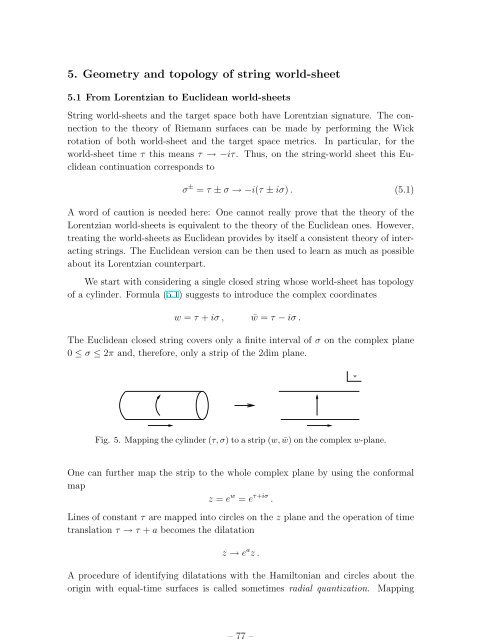Lectures on String Theory
Lectures on String Theory
Lectures on String Theory
Create successful ePaper yourself
Turn your PDF publications into a flip-book with our unique Google optimized e-Paper software.
– 77 –<br />
5. Geometry and topology of string world-sheet<br />
5.1 From Lorentzian to Euclidean world-sheets<br />
<strong>String</strong> world-sheets and the target space both have Lorentzian signature. The c<strong>on</strong>necti<strong>on</strong><br />
to the theory of Riemann surfaces can be made by performing the Wick<br />
rotati<strong>on</strong> of both world-sheet and the target space metrics. In particular, for the<br />
world-sheet time τ this means τ → −iτ. Thus, <strong>on</strong> the string-world sheet this Euclidean<br />
c<strong>on</strong>tinuati<strong>on</strong> corresp<strong>on</strong>ds to<br />
σ ± = τ ± σ → −i(τ ± iσ) . (5.1)<br />
A word of cauti<strong>on</strong> is needed here: One cannot really prove that the theory of the<br />
Lorentzian world-sheets is equivalent to the theory of the Euclidean <strong>on</strong>es. However,<br />
treating the world-sheets as Euclidean provides by itself a c<strong>on</strong>sistent theory of interacting<br />
strings. The Euclidean versi<strong>on</strong> can be then used to learn as much as possible<br />
about its Lorentzian counterpart.<br />
We start with c<strong>on</strong>sidering a single closed string whose world-sheet has topology<br />
of a cylinder. Formula (5.1) suggests to introduce the complex coordinates<br />
w = τ + iσ , ¯w = τ − iσ .<br />
The Euclidean closed string covers <strong>on</strong>ly a finite interval of σ <strong>on</strong> the complex plane<br />
0 ≤ σ ≤ 2π and, therefore, <strong>on</strong>ly a strip of the 2dim plane.<br />
w<br />
Fig. 5. Mapping the cylinder (τ, σ) to a strip (w, ¯w) <strong>on</strong> the complex w-plane.<br />
One can further map the strip to the whole complex plane by using the c<strong>on</strong>formal<br />
map<br />
z = e w = e τ+iσ .<br />
Lines of c<strong>on</strong>stant τ are mapped into circles <strong>on</strong> the z plane and the operati<strong>on</strong> of time<br />
translati<strong>on</strong> τ → τ + a becomes the dilatati<strong>on</strong><br />
z → e a z .<br />
A procedure of identifying dilatati<strong>on</strong>s with the Hamilt<strong>on</strong>ian and circles about the<br />
origin with equal-time surfaces is called sometimes radial quantizati<strong>on</strong>. Mapping

















